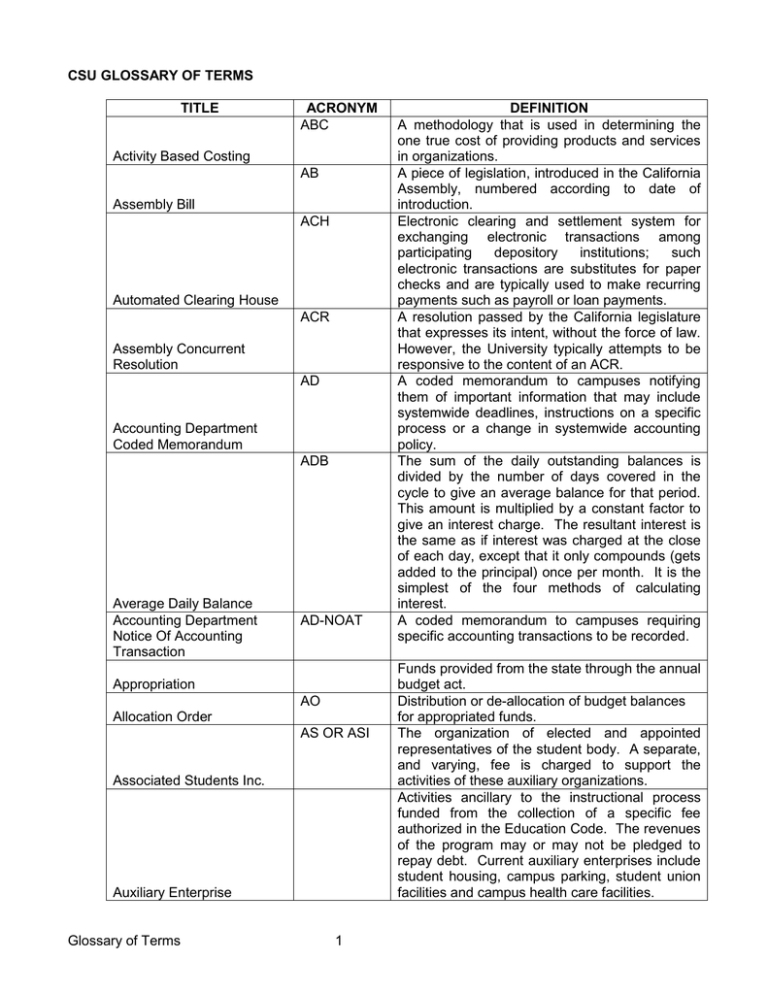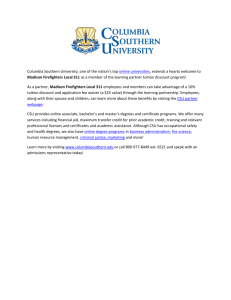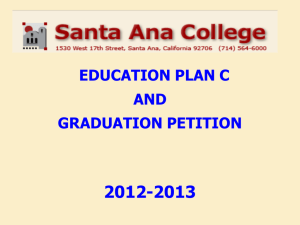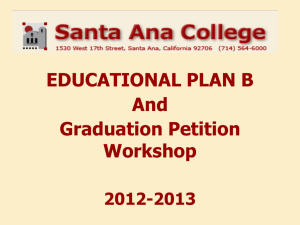ABC A methodology that is used ... one true cost of providing ... CSU GLOSSARY OF TERMS
advertisement

CSU GLOSSARY OF TERMS TITLE ACRONYM ABC Activity Based Costing AB Assembly Bill ACH Automated Clearing House ACR Assembly Concurrent Resolution AD Accounting Department Coded Memorandum ADB Average Daily Balance Accounting Department Notice Of Accounting Transaction AD-NOAT Appropriation AO Allocation Order AS OR ASI Associated Students Inc. Auxiliary Enterprise Glossary of Terms 1 DEFINITION A methodology that is used in determining the one true cost of providing products and services in organizations. A piece of legislation, introduced in the California Assembly, numbered according to date of introduction. Electronic clearing and settlement system for exchanging electronic transactions among participating depository institutions; such electronic transactions are substitutes for paper checks and are typically used to make recurring payments such as payroll or loan payments. A resolution passed by the California legislature that expresses its intent, without the force of law. However, the University typically attempts to be responsive to the content of an ACR. A coded memorandum to campuses notifying them of important information that may include systemwide deadlines, instructions on a specific process or a change in systemwide accounting policy. The sum of the daily outstanding balances is divided by the number of days covered in the cycle to give an average balance for that period. This amount is multiplied by a constant factor to give an interest charge. The resultant interest is the same as if interest was charged at the close of each day, except that it only compounds (gets added to the principal) once per month. It is the simplest of the four methods of calculating interest. A coded memorandum to campuses requiring specific accounting transactions to be recorded. Funds provided from the state through the annual budget act. Distribution or de-allocation of budget balances for appropriated funds. The organization of elected and appointed representatives of the student body. A separate, and varying, fee is charged to support the activities of these auxiliary organizations. Activities ancillary to the instructional process funded from the collection of a specific fee authorized in the Education Code. The revenues of the program may or may not be pledged to repay debt. Current auxiliary enterprises include student housing, campus parking, student union facilities and campus health care facilities. TITLE ACRONYM Auxiliary Organization AY Academic Year AOA Auxiliary Organization Association BANs Bond Anticipation Notes CPEC California Postsecondary Education Commission CMO Cash Management Operations CPO Cash Posting Order CSU Operating Fund CABO Chief Administrative/Business Officers Glossary of Terms 2 DEFINITION Separate legal entities authorized in the Education Code to provide essential services to students and employees. They operate in association with campuses pursuant to special written agreements, and are authorized to perform specific functions that contribute to the educational mission of the campus. Examples of auxiliary organizations are student body organizations, student union operations, bookstores and other commercial activities and foundations providing research and sponsored educational projects and/or development activities. Auxiliary organizations must be selfsupporting and do not receive funding from General Fund sources. An annual period beginning with the fall term and ending with the spring term. For campuses on a year round quarter system operation, a total of any three quarters of approximately the same length. An organization composed of auxiliary organizations on CSU campuses. It works to facilitate the role of individual auxiliaries on their respective campuses by providing the auxiliaries with the resources and services that enable them to be more effective. Short term debt instruments issued in anticipation of longer debt being issued. In the case of the CSU, BANs are issued in support of the CSU’s commercial paper program. Established in 1974 as the planning and coordinating body for higher education in the state of California. The Commission provides the legislative and the executive branches of government with advice and information about major policy and planning issues concerning education beyond high school A function within the Resource Management area of Financial Services responsible for the movement and tracking of the CSU's cash, its banking services, and the distribution of investment income. A transfer of cash balances between one CSU agency and another within SWIFT. A government fund established by the CSU to account for all transactions of a campus that are not accounted for in another CSU fund group (see EO 1000). A group consisting of the senior financial officers from each of the campuses, which serves in an advisory capacity to the CFO of the system. Both FOA and PSSO are subsidiaries of CABO. TITLE California Community Colleges ACRONYM CCC CDIP Corporate Data Integrity Program CERF Continuing Education Revenue Fund California Faculty Association CFA CMAS CA Multiple Award Schedule CMS Common Management System Council of Library Directors COLD CP Commercial Paper CPA Central Payroll Activity CPDC Capital Planning, Design And Construction Commercial Paper Equipment Program CPEP CY College Year Calendar Year Current Year DGS Department of General Service DOF Department Of Finance Glossary of Terms 3 DEFINITION The term used to refer collectively to all the community colleges in California. A comprehensive system of program derivation rules and combo edits designed to standardize systemwide financial reporting products. Continuing education provides an increasingly broad spectrum of educational services to public and private agencies, as well as to a large number of persons who seek advanced educational training to help them increase their occupational competency or to otherwise enrich their lives. Courses and programs include both credit and non-credit instruction and may be administered through CERF or the Continuing Education Trust Fund. Participants do not need to be matriculated students. The collective bargaining union that represents the faculty at the CSU campuses. A contract negotiated by the state Department of General Services offering discounts to all eligible state agencies for specific goods or services. A project intended to establish a target administrative environment on all CSU campuses by using a common suite of applications software with a shared data center. Subject matter group within the CSU. The Commercial Paper program is a short term financing vehicle used to finance DRF projects during the construction period to lower cost of borrowing. Monthly transaction to fund payroll activity initiated by the Cash Management Operations group. The department of the chancellor’s office that manages the capital construction program for all campuses. The Commercial Paper program that provides equipment financing to campuses. Definition depends on the context in which the acronym is being used. College year is typically used regarding enrollment; calendar year can be either academic-related or fiscal-related; and current year typically refers to budget or fiscal issues. The purchasing and contracting agency for state agencies. While CSU has its own contracting authority there continues to be some interaction with DGS. The executive control agency of state government responsible for advising the Governor on all fiscally related issues. TITLE Dormitory Revenue Fund Enhanced Capital Management ACRONYM DRF ECM EFT Electronic Funds Transfer Environmental Health & Safety EH&S EIR Environmental Impact Report EO Executive Order EOP Educational Opportunity Program ERSS Enrollment Reporting Student Systems Facilities and Administrative Costs Financial Accounting Standards Board F&A FASB FBC Fund Balance Clearing FIRMS Financial Information Record Management System FNAT Fund Attribute Glossary of Terms 4 DEFINITION Proceeds from bond sales to support auxiliary enterprise activities are deposited in the DRF in accordance with the CSU Bond Act of 1947. see SRB The transfer of money between accounts by electronic systems such as automated teller machines (ATMs), and electronic payment of bills. Each campus has an officer, or more, designated to manage this aspect of risk management. The California Environmental Quality Act (CEQA) requires all public agencies to disclose any significant adverse impact that a proposed capital outlay project or lease may have upon the environment. The process/document which evaluates the potential impact is called an EIR. A policy statement issued by the Chancellor that governs activity at the campuses. An admissions and retention program for lowincome undergraduate students who are disadvantaged because of economic and educational backgrounds. There is a financial assistance component to the program. The system used to collect and report enrollment data for the campuses and system. Statistical reports are generated from this data. A method of computing indirect costs for the Federal Government. The rulemaking body for non-governmental accounting standards. An account in the Equity account group used to record each agency’s balance in a State (SCO) fund maintained at the CO. This account is excluded for the purpose of calculating the current Retained Earnings balance in nongovernmental funds. The CSU corporate standard used to ensure compliance with reporting requirements for financial information. It includes a uniform financial accounting classification and reporting structure. FIRMS does not includes data elements that campuses need in operational systems to meet local day-to-day needs. FNAT refers to the PeopleSoft Fund Attribute key that is assigned to a PeopleSoft Fund when it is first created. The key is used to assign various State and CSU attributes to the fund. These attributes are used for external reporting requirements with the state, FIRMS and GAAP. TITLE Financial Officers Association Financial Standards Advisory Committee Full Time Equivalent Faculty Full Time Equivalent Student Full Time Equivalent Positions Finance Users Group Fiscal Year General Fund Generally Accepted Accounting Principles Governmental Accounting Standards Board Gift Annuity Glossary of Terms ACRONYM FOA DEFINITION An organization composed of the Associate (Assistant) Vice President, Accounting, or Budgeting Officer from each of the CSU campuses. Its’ primary mission is to plan, develop and communicate new and improved policies and procedures related to accounting and budgeting issues and facilitate personal and professional development and training for financial staff on the campuses. FSAC This CSU-representative group establishes the rules, standards, and financial accounting and reporting models for all campuses and related entities within the CSU system. FTEF Sum of the position fractions of individual faculty members. For example, two part-time faculty working halftime comprise one full-time equivalent faculty. FTES or just A unit of measure equal to 15 semester or FTE quarter units per term. FTE is reached by dividing total semester or quarter hours by 15. FTE The total number of full time employees plus the full time equivalent of the part time employees. The amounts are calculated and fed from Peoplesoft Human Resources to Peoplesoft Finance to report the amounts quarterly to the Systemwide Financial Reporting group as part of the FIRMS submission. FUG CSU team that advises on the implementation of Peoplesoft financial software. FY The 12-month period beginning July 1 and ending the following June 30. GF The State General Fund is used as the major funding source for education (K - 12 and higher education), health and welfare programs, youth and adult correctional programs, and tax relief. The primary sources of revenue for the General Fund are the personal income tax, sales tax, and bank and corporation taxes. GAAP The campuses of the CSU maintain their financial records and reports on the legal basis of accounting, which is required reporting for the State. The legal basis of accounting is not considered GAAP in that the accrual basis of accounting is not utilized on a consistent basis. In order to prepare annual financial statements in accordance with GAAP, campuses must perform several conversion steps. GASB The rulemaking body for governmental accounting standards. A contract between a CSU foundation and the donor. The donor receives an income for life and upon their death the gift goes to the foundation. 5 TITLE Higher Education Users Group Industrial Disability Leave ACRONYM HEUG IDL IPEDS Integrated Postsecondary Education Data System IRA Instructionally Related Activity Information Security Officer ISO ITAC A subject matter interest group with the CSU composed of the senior information technology officer from each campus. An institution permitted under California law where two or more public authorities operate collectively. A JPA is distinct from the member authorities. They have separate operating boards of directors, and these boards can be given any of the powers inherent in all of the participating agencies. In setting up a JPA, the constituent authorities must establish which of their powers the new authority will be allowed to exercise. A process that distributes salary and benefit costs by FIRMS CSU / State Fund. CSU payroll is processed with the SCO in one fund; however, it is necessary for CSU to assign costs to the CSU / State Fund that incurs the salary and benefit costs for internal campus and systemwide analyses and reporting purposes. An investment vehicle available to local government agencies including auxiliary organizations. It is managed by the State Treasurer and provides low risk, short-term earnings on funds invested. An independent state agency that advises the legislature on fiscal and policy issues. Funds derived from the California State Lottery to supplement money allocated for the education of pupils and students in public education in California. Information Technology Advisory Council JPA Joint Powers Authority LCD Labor Cost Distribution LAIF Local Agency Investment Fund LAO Legislative Analyst’s Office Lottery Fund Glossary of Terms DEFINITION The HEUG is an affiliate group of staff within Higher Education that implemented the PeopleSoft enterprise applications – Finance, HR and Student. The annual conference is called the Alliance and brings thousands of Higher Ed Users together to network and share best practice uses of the PeopleSoft Applications. Long term worker’s compensation IPEDS is the core postsecondary education data collection program for the National Center for Education Statistics. Data are collected from all primary providers of postsecondary education in the country in areas including enrollments, program completions, graduation rates, faculty, staff, finances, institutional prices, and student financial aid. A campus fee used to support student activities related to instruction (e.g., intercollegiate athletics, creative arts performances, student publications, forensics) 6 TITLE Management Personnel Plan Memorandum of Understanding ACRONYM MPP MOU MTDC Modified Total Direct Costs NACUBO National Association Of College And University Business Officers Non-Industrial Disability Insurance Non-Resident Alien (or NonResident Alien Tax) Office of the University Auditor NDI NRA or NRAT OUA Orange Book P-Card Procurement Card PERB Public Employment Relations Board PFA Plan Of Financial Adjustment PS PeopleSoft PSSO Procurement and Support Services Officers Glossary of Terms DEFINITION The MPP was and is designed to be a flexible personnel program consisting of four very broad generic classification levels (Administrator I, II, III and IV) and correspondingly broad salary ranges, used for management and supervisory employees with the CSU. An expression of the terms of agreement and responsibilities of the parties to a contract. A method of computing indirect costs for the Federal Government (Long Form) NACUBO is a nonprofit professional organization representing chief administrative and financial officers at more than 2,100 colleges and universities across the country. Over two-thirds of all institutions of higher learning in the United States are members of NACUBO. NACUBO's mission is to promote sound management and financial practices at colleges and universities. Wage supplement for workers not able to work due to a non-work related disability. Individuals who do not qualify as U.S. residents according to federal regulations, but may still be subject to taxation on payments made to them. 7 A reference manual that included formulas to drive funding for many parts of the campus operation. Formula-driven funding, and the orange book, ceased being used in 1993-94. A commercial credit card issued to employees through a bank or other financial institution to be used to simplify the purchase of low dollar goods and services. A quasi-judicial administrative agency charged with administering the collective bargaining statutes covering employees of California's public schools, colleges, and universities, employees of the State of California, and other public agency employees. Allows agency to pay out of one appropriation and then identify costs properly belonging to other appropriations. The State Controller transfers these expenditures from the originally charged appropriation to the alternately charged appropriation upon request by the campus or chancellor’s office. The software selected to manage the CMS project and administrative work environment. A systemwide group, similar to FOA, composed of the senior purchasing/contracting officers at each campus, which advises CABO on purchasing and related issues. TITLE ACRONYM Productivity Pro Rata QI Quality Improvement RA Remittance Advice Reimbursements RFP Request for Proposals RMP Revenue Management Program Sabbatical Leave SAM 99 State Administrative Manual report #99 SB Senate Bill SCO State Controller’s Office SCT Banner System Supplemental Educational Opportunity Grant SEOG SFO A department with the Business and Finance division of the CO that handles systemwide accounting activities (ex. SRB, Lottery, Capital Projects, etc.) Systemwide Financial Operations Glossary of Terms DEFINITION Increased efficiency or reduced costs per FTES within the campus. Sharing of general funded central service costs by funds other than General Fund. In general, non-billable funds are those whose source of revenue is the General Fund or a Federal fund. Billable funds are those that are funded by special revenue sources such as continuing education fees, parking fees, or housing fees. A program in place at most of the campuses, supported by a team of staff at the chancellor’s office, that promotes continuous quality and productivity improvement in the California State University Notification to the SCO to record cash transactions to an agency on account at the SCO. TC-47 The cost of services provided by the University is paid by a sponsoring source (e.g., the cost of Police Service paid by the General Fund for an event is reimbursed by an auxiliary enterprise or organization or from an outside source). A Request for Proposal is a document issued by an organization to elicit bids from potential vendors for a good or a service. In 2006 the Education Code was amended to allow the CSU to deposit fee money into a locally held trust. This change in fund management has resulted in the need to significantly modify the University’s business processes. A paid leave of absence by a faculty member granted in accordance with a faculty contract or policy. A computer-generated analysis comparing campus financial records to State Controller accounts. A piece of legislation, introduced in the California Senate, numbered according to date of introduction. Is the Chief Financial Officer for the state and acts as a control agency for many fiscal functions in the CSU. An integrated administrative software system that handles student, faculty and staff information along with modules for human resources, financial aid, and alumni tracking. A federal financial aid program. 8 TITLE ACRONYM SFR Systemwide Financial Standards and Reporting SMIF State Money Investment Fund SRB Systemwide Revenue Bond State Treasurer’s Office STO SUAM State University Administrative Manual SUF State University Fee SUG State University Grant SWAT Systemwide Allocation Transfer Systemwide Investment Funds Trust SWIFT TSC Technology Steering Committee UBIT Unrelated Business Income Tax UI Unemployment Insurance 204 Form Vendor Data Record WACUBO Western Association Of College And University Business Officers WFB Wells Fargo Bank Glossary of Terms 9 DEFINITION A unit with the Financial Services—Accounting department that manages GAAP and other financial reporting issues. The primary investment vehicle used by state agencies. It is managed by the State Treasurer and provides low risk, short-term earnings on funds invested. New (2002) long-term debt management program designed to reduce costs overall and maximize capacity limits. Uses a broad, multisource pledge for all bonds, including auxiliary enterprise and auxiliary organization capital projects. The state’s cash management office. Codified policy statements about operations within the university. Currently only capital planning and contracts maintain and use this process to express policy. A systemwide fee that must be paid by all students who enroll in or attend the university. A financial aid program unique to the CSU, which provides grants to offset the impact of fee increases for eligible students. CSU sets aside one-third of incremental State University Fee revenue from enrollment growth and fee increase to address a continuing shortfall in student financial aid. A transfer of cash from systemwide Budget Office to a campus agency; replaces General Fund Supplemental Allocation Orders. This is the CSU’s main investment vehicle for the investment of trust funds. A presidentially-led advisory group focused on all technology issues, including implementation the CSU’s strategic plan. Federal income taxes levied on activities that are not directly related to the mission of the university. A program that pays employees when they have been laid off. Campuses pay funds into the program. Information collected on this form is necessary for tax and other reporting requirements. No payments can be made to individuals or businesses without completion of the 204 form. A membership organization for university business officers. This is one of four regional associations of the national organization. Geared toward professional development and resource/information sharing. Commercial bank providing depository and disbursement services for CSU agencies. TITLE ACRONYM YRO Year Round Operations Glossary of Terms 10 DEFINITION The initiative to move all CSU campuses to a year-round calendar of state-supported course offerings as one means to address the anticipated enrollment demand during the next decade. KPMG Acronyms TITLE Audit Program Guide Entity Level Controls Information Risk Management KPMG Sampling Plan Monetary Unit Sampling Prepared by Client Prior Period Adjustment Risk of Significant Misstatement Summary of Adjusted Differences Statement on Auditing Standards Summary of Internal Control Deficiencies Summary of Significant Accounting Policies Summary of Unadjusted Differences Glossary of Terms ACRONYM APG ELC IRM KSP MUS PBC PPA RoSM SAD SAS (i.e. SAS 99, 112) SICD SOSAP SUAD 11





